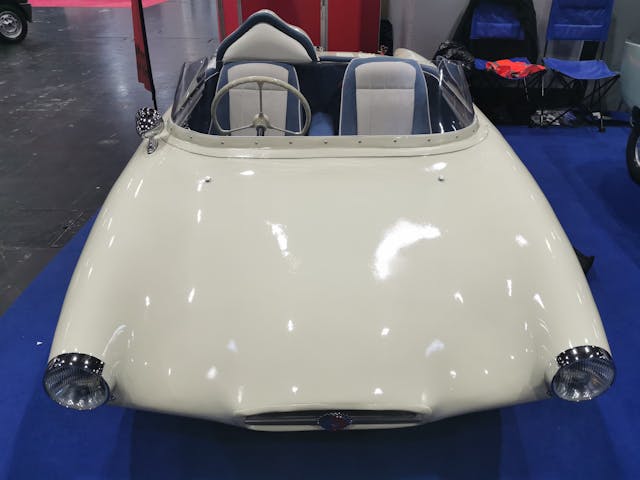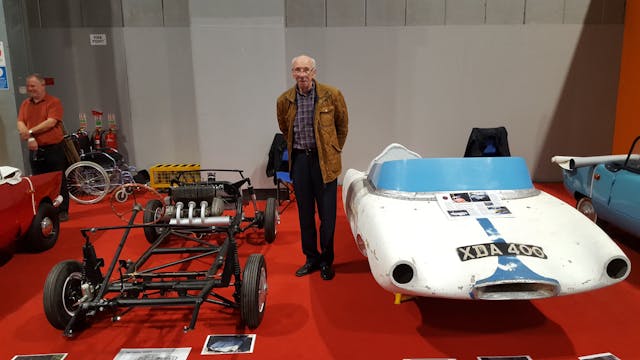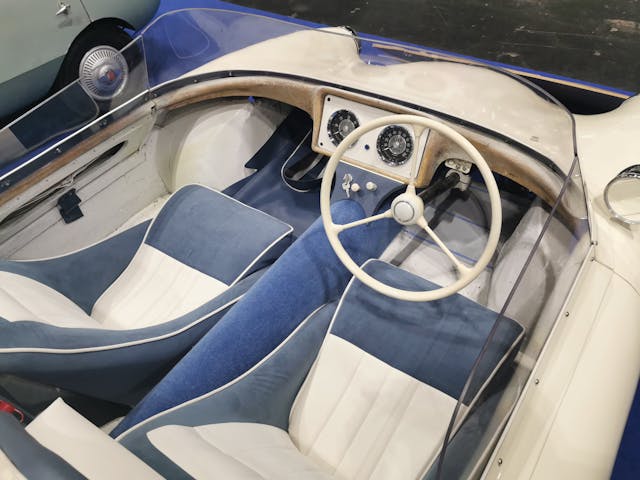A Frisky One: Oddball microcar returns after 64 years
Last seen at the 1958 London Motor Show, the only Meadows Frisky Sprint in existence was revealed to the public once more—following a race against time to make the deadline. Visitors to last weekend’s Classic Car and Restoration Show in Birmingham, U.K., viewed the happy results of a year-long revival, carried out by the Frisky Register, following its rediscovery in a garden.
It wasn’t the first time a Frisky had upstaged more glamorous metal, either. A year earlier, a Vignale-built, Michelotti-styled, gull-winged Frisky Bug garnered a terrific reaction from show-goers. Sadly, these upstart draws of the 1957 Geneva Motor Show were destroyed afterwards, their gull-wing-doored bodies impractical for mass production; buyers got the revised Friskysport, instead.
The Frisky Register revealed the Sprint’s tragic back story; it wasn’t alone. Stored in the garden of Graham Wright, whose family were Frisky’s fourth owners, it was joined in quiet decay by two other Frisky models: a Prince (three of which remain) and a Family Three Mark 2.
Built for a production run of turn-key 500cc racing cars that never commenced, the Sprint had an impressive pedigree. Former Kieft designers, Gordon Bedson and Keith Peckmore, designed the car on Meadows’ behalf to capture a slice of the post Suez-crisis sports car market, having previously shaped the late Stirling Moss’s Formula 3 car.

It was the era of the kit-built special. If a cash-strapped enthusiast wanted a sports car, they rebodied a pre-war car with a fiberglass body built using the donor car’s chassis and engine.
While microcar manufacturers sought to make the most of whatever resources and budgets were available, some offered sports cars for a few pounds more; the likes of Berkeley and Goggomobile (via an Australian firm, Buckle Motors Pty) joined Frisky in this pretension.
The Sprint’s ambitions were well-targeted, but a change of company ownership derailed its fortunes. Bedson and Peckmore left for the Lightburn company in Australia, and the only Sprint in existence was consigned to one-off status.
“It was to be the people’s race car, whereas the Friskysport was to be the people’s transport,” said John Meadows, founder of the Frisky Register. The grandson of Henry Meadows, he formed the Frisky Register in 1978, and had been searching for the missing car for more than 30 years.

Graham Wright’s passing in June 2021 brought the Sprint’s plight to the attention of the Frisky Register; on collection, with Keith Peckmore in tow, it made for an emotional reunion. Peckmore visited the car during its time on the Register stand during last year’s Classic Motor Show; now aged 93, he’s confident that the car is in the right hands. The Sprint’s owner, Malcolm Dudley, also owns the second Friskysport prototype, which he acquired in 2011.
The Sprint was (mostly) complete, together with its original registration mark, XDA 400. Its three-cylinder, triple carburetor Excelsior engine was seized, but its chassis, stacked on a trestle table together with chassis of two other Friskys, had survived in good condition. Less could be said for the body, however, which had the Prince’s hull placed atop for a decade.
There were many challenges to overcome, but for the next year the Frisky Register worked feverishly to fabricate the combined engine cover and headrest, and the missing floor pan, which sat on the chassis and funneled air to the mid-rear mounted engine.

There were other problems, too. While the drop-down doors and handbrake and gear lever were found adjacent to the car, its headlights, instruments and windscreen were nowhere to be seen. The chassis was missing its front suspension and steering linkage, but—in scenes reminiscent of an Easter egg hunt—the pedal box and steering column were retrieved from elsewhere in the garden.
While work commenced un-seizing the engine, bereft of carburetors, a crashed Frisky Family Three chassis donated its front clip (the main components forward of the windscreen line). Attention then turned to the body, squashed under the remains of the Prince, owing to a lack of space. Photos and diligent fabrication repaired the inner wheel arch, located the missing instrument cluster, and recreated the windscreen.
Contact with the Berkeley club located the throttle and choke linkages for the Excelsior, and its Amal carburetors were tracked down on eBay.
Sidelined, stacked up and stored away for more than six decades, the Sprint was the Restoration Show’s undoubted star. But how many show-goers will have realized that this true rarity was rescued from a gloomy fate?



Amazing how many old cars surface after decades in the unknown. Here in New Zealand, there are ensembles of cars from the rest of the world, languishing in sheds , waiting for their keepers to pass.